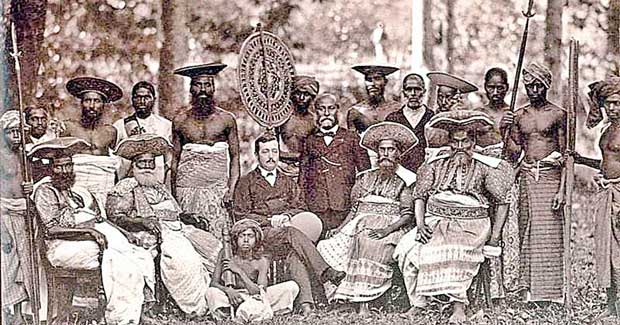Reply To:
Name - Reply Comment

The rift between exoticising a culture – thereby turning it into an object of study and assessment – and expatriating it – thereby looting and destroying its artefacts, its cultural relevance – is actually a fiction. There’s no rift, in other words, and if there is, it is largely fictional, and like all fictions is maintained to promote the kind of superficial gloss that Orientalism has thrived on: a separation of the material from the ideological in  the West’s dealings with the East. What is there in the robbery of the Koh-i-Noor that bears any resemblance to the destruction of the temple and the kovil? The assumption, sustained mischievously by Western scholars and intellectuals was, that the East was there only to be objectified, studied, and validated as inferior, ignorant, and immaterial. Back in the day the colonial project armed itself with religious tracts on the one hand and the sword on the other; now we have substituted that magic, otherworldly phenomenon called “globalisation” for those tracts.
the West’s dealings with the East. What is there in the robbery of the Koh-i-Noor that bears any resemblance to the destruction of the temple and the kovil? The assumption, sustained mischievously by Western scholars and intellectuals was, that the East was there only to be objectified, studied, and validated as inferior, ignorant, and immaterial. Back in the day the colonial project armed itself with religious tracts on the one hand and the sword on the other; now we have substituted that magic, otherworldly phenomenon called “globalisation” for those tracts.
If there’s to be any meaningful attempt at globalisation there must be an exchange, as such, in the realms of culture and politics, which are, as I pointed out last week, interconnected. But we have been content with a globalisation that promotes affluence and materialism on the one hand and poverty and exploitation on the other. We advertise poverty to invite materialism, which as Professor Nalin de Silva rightly has noted depends on a largely Judeo-Christian frame of (two-valued) logic. Either it is, or it is not. Such a frame of logic can be squared with a dualistic conception of the world as it is and is not. The West has taken upon itself the role of defining what that world is, and should be, and what it is not, and should not be. Not hard to figure out who’s behind what in this sorry state of affairs we refer to as modernity. Today.
Kissinger, the realpolitik of 19th century Europe to 20th century America, speaks for his clique when he writes that the East never went beyond the Newtonian phase of history
That essay of Henry Kissinger which I referred to last week (“Domestic Structure and Foreign Policy”) manifestly reflects all these points. Kissinger, who among other things is a Nobel Peace Prize recipient and a diplomat who introduced the realpolitik of 19th century Europe to 20th century America, speaks for his clique when he writes that the East never went beyond the Newtonian phase of history. What he means there is that the West is materialist, that it believes in an external reality independent of the senses, and that the East believes in “internalising” its surroundings. Edward Said alludes in his  book to another essay, one by a renowned psychiatrist (Harold Glidden) and written in 1972, which extrapolates and contends that the Arab culture as such was based on a “client-patron” relationship that in turn promotes subservience and dominance. The dichotomy is clear: the West is domineering, destined to conquer; the East is doomed to serve, to be conquered. The one will win; the other shall lose.
book to another essay, one by a renowned psychiatrist (Harold Glidden) and written in 1972, which extrapolates and contends that the Arab culture as such was based on a “client-patron” relationship that in turn promotes subservience and dominance. The dichotomy is clear: the West is domineering, destined to conquer; the East is doomed to serve, to be conquered. The one will win; the other shall lose.
Perhaps some points need to be made here. Perhaps we need to be reminded that when European doctors and students were actively banned from dissecting bodies, the so-called ignorant Arabs had discovered cures for several diseases. Perhaps we need to note that the Renaissance, which preceded the Reformation, the Counter-Reformation, and the Enlightenment, involved actively the confusion and congruence of both the West and the East, and that a key painting from this period, Raphael’s The School of Athens, depicts Averroes and Zoroaster alongside Aristotle and Euclid. Perhaps we need to remember that the humanistic values which survived the Inquisition, and which were reinvigorated during the Renaissance, could not survive the Reformation and the Enlightenment, which respectively promoted religious and secular values against the East, by now again demarcated as ignorant and ignoble.
In my article on liberalism that the White American Liberal has always sought to define the Negro on his terms, and not the Negro’s. The liberal does this by idealising a perfect variant of the former slave
Perhaps we also need to remember the role that popular culture has played in propagating these dualisms, mischievous and unnecessary as they are and always were. Kipling’s India was not Forster’s India, Emerson Tennent’s Ceylon was not Woolf’s Ceylon. The shift from the one to other was the shift from a conservative to a liberal. Kipling has been denoted as a rightwing neo-fascist (regardless of his detractors and followers those epithets have followed him beyond the grave), but his depictions of Indian life were so accurate, if not romanticised, as to have come from an actual Indian. The same could have been said of Tennent, whose two-volume account of Ceylon is a testament to the coloniser’s interest in knowing the East more than the typical Westerner and even Easterner. Orient and Occident met, for a brief, intermittent period, with the bureaucrat and the artist; when the artist turned liberal, as Forster and Woolf did, there was a critique not just of the colonial system, but how that system spawned its own horde of brown sahibs, Mudliyars, and Muhandirams.
I noted in my article on liberalism that the White American Liberal has always sought to define the Negro on his terms, and not the Negro’s. The liberal does this by idealising a perfect variant of the former slave, which is how Stanley Kramer turned Sidney Poitier into John Prentice (from Guess Who’s Coming to Dinner). But these were, while condescending, not really unflattering portraits of the Other. Such unflattering if not racist depictions of the Other came about when writers, poets, and filmmakers looked to the East as a means of vindicating their part of the world. It takes an entire film starring Cary Grant and Douglas Fairbanks Jr for a contorted, black-faced Indian played by a Jewish American to earn the line, “You’re a better man than I am, Gunga Din.” The Indian is better than the Englishman because he serves that Englishman. He serves the Englishman by being a stupid, incompetent, and downright simplistic man. In Gunga Din that Indian can’t even march straight: his shoulders are always bent, his eyes always bulging too much. He can’t be a better soldier, and among soldiers he can only be a better man to join their ranks.
Popular culture, is ambivalent, unclear, at times mischievously inaccurate. Pauline Kael once wrote can be taken as an indication that the popular culture is strewn with stereotypes and mythical depictions
Popular culture, as I’ve observed many times in this column, is ambivalent, unclear, at times mischievously inaccurate. “The movie industry is always frightened, and is always proudest of films that celebrate courage,” Pauline Kael once wrote, and what she wrote can be taken as an indication that the popular culture we inhabit is strewn with stereotypes and mythical depictions of the Other which, while made to gain sympathy for those being depicted, actually sustains the interests of the intellectuals and academics that Edward Said attacked in his monumental book on Orientalism. Remember Mickey Rooney as Yunioshi from Breakfast at Tiffany’s, or Rooney as Flip, the minstrel-show Negro-like toad, from Little Nemo: Adventures in Slumberland? Well, those depictions were ostentatiously innocent, unintended. But nothing is ever unintended. No one is ever innocent. It’s more complex than that.
What do all these lead us to? The final journey from exoticising a culture to expatriating it, naturally. To be sure, not every mode of expatriation can be considered negative, regressive, harmful – think of Maurice Jarre’s beautiful score for David Lean’s A Passage to India, or Ravi Shankar’s attempts at Western melodies and instruments, or closer to home, Premasiri Khemadasa’s act of bringing the opera and the symphony to Sri Lanka – and obviously much of what is exchanged in cultural terms is to be welcomed as positive, progressive, and liberating.
But just as fictitious as the supposed rift between the cultural and the political (and this rift, I myself subscribed to until recently) is the rift between assessing a culture and destroying it. The one uses religious tracts, or secular science; the latter uses weapons. “Sextus, you ask how to fight an idea. Well I’ll tell you how: with another idea,” Messalah declares in Ben-Hur. The clash of ideas being roughly equivalent to the clash of civilisations (as per Huntington), we can hence conclude that cultural exploitation is no different to political exploitation, in terms of their ability to alienate and uproot a way of life, indeed even a way of looking at the world.
In the end nothing is ever innocent. Kissinger may argue about how our part of the world is still stuck in the pre-Newtonian phase of human history, and Glidden may contend that we Easterners can only succumb, yield, and be psychologically dominated. But consider the extrapolation this leads us to: as Kissinger notifies us quite honestly and candidly, the dichotomy between the Orient and the Occident requires that the West construct an international order “before a crisis imposes it as a necessity.” In still other words, before hell breaks loose in this part of the world, it’s best that the West intervenes, meddling in our state of affairs if necessary, resorts to whatever permissible, legal methods to cleanse us of our sins, and then leaves.
It doesn’t get any more innocent than that, folks. Today, tomorrow, or the day after.